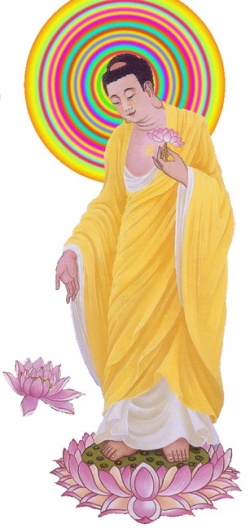Mūla prajñā
Three prajñās ormūla prajñā
Norbu et al. render the mūla prajñā (Sanskrit) where mūla may be set into English as "root" (as of a tree), thus:
Study (Pali: [[sutamayā paññā, Sanskrit: śruta, Tibetan: thos + pa)
Reflection (Pali: cintāmayā paññā, Sanskrit: cintā, Tibetan: sam+ pa)
Meditation (Pali: bhāvanāmayā paññā, Sanskrit: bhāvanā, Tibetan: sgom pa)
In an article on Vipassana Research Institute, these three sources of panna are explained as followed.
Cintāmayā paññā is the wisdom obtained from one's own thinking, not just from hearing others (parato asutva patilabhati). It is the understanding of impermanence, suffering and essencelessness, from what one has grasped by the means of one's own intellect. It is the process of intellectually analyzing something to see whether it is logical and rational. Having gone through such a process, one can then accept a teaching intellectually. One may thereby become knowledgeable about the theory of Dhamma, and may be able to explain it to others. One may even be able to help others realize the fact of anicca, dukkha and anatta, but still one cannot obtain liberation for oneself. On the contrary, there is a danger that one may accumulate more mental defilements by developing ego since one lacks the direct experience of wisdom.
Sometimes we find in the texts a change in the order of sutamayā paññā and cintāmayā paññā. At times cinta-maya panna is mentioned first, followed by suta-maya panna andbhavana-maya panna. At times, suta-maya panna is followed by cinta-maya panna and bhavana-maya panna. But in both cases, bhavana-maya panna comes at the end and is of prime importance for the realisation of truth. It does not make any difference in which order we find the first two. Initially a person may listen to the Dhamma from an outside source- suta-maya panna, and then develop cinta-maya panna by rationally thinking about it, trying to understand anicca, dukkha and anatta intellectually, and thereby develop yoniso manasikara (right thinking). Or one may start with cinta-maya panna, one's own intellectual understanding, by reflecting rationally on anicca, dukkha and anatta, and then, by listening to others (suta-maya panna), one may confirm one's intellectual understanding. We should remember that whichever of the two may come first, neither of them can give liberation. Liberation results only from bhavana-maya panna.
Bhāvanāmayā paññā is the wisdom obtained by meditation -- the wisdom that comes from the direct experience of the truth. This development of insight is also called vipassana- bhavana (Vipassana meditation). The meditator makes right effort and so realizes for himself that every thing in the world is transitory, a source of suffering, and essenceless. This insight is not the mere acceptance of what someone else has said, nor the product of deductive reasoning. It is, rather, the direct comprehension of the reality of anicca, dukkha and anatta.
To develop bhāvanāmayā paññā, we must experience all phenomena and understand their true nature. And this is done through experiencing vedana, (bodily sensations), because it is through these sensations that the totality of our nature manifests itself as pancakkhandha (the five aggregates).
These three aspects are the mūla prajñā of the sādhana of Prajñā-Pāramitā, the "pāramitā of wisdom". Hence, these three are related to, but distinct from, the prajñāpāramitā that denotes a particular cycle of discourse in the Buddhist literature, that which relates to the doctrinal field (Sanskrit: kṣetra ) of the second turning of the Dharmachakra.
Gyatrul (b. 1924), in a purport to the work of Chagmé (Wylie: karma-chags-med, fl. 17th century), rendered into English by Wallace, conveying the importance of internalizing and integrating the doctrine by extending the metaphor, states:
...do not let your Dharma be like rice in a bowl, always remaining separate from the container. Rather, apply Dharma by means of hearing, thinking, and meditating. One of these alone is not enough. All three must be practiced. If you lack hearing and thinking, you are not in a good position to meditate effectively. Such meditation is like trying to climb a mountain without your hands. However much you learn of the Dharma, practice it with faith and compassion. Apply it to your own mind.
In a commentary to Rangjung Dorje's Namshe Yeshe Gepa (Wylie: rnam shes ye shes ‘byed pa) by Khenchen Thrangu Rinpoche rendered into English by Peter Roberts (2001), the mūla prajñā are discussed thus:
We shouldn't believe in something just because the Buddha, or some great scholar or lama says so. We need a very clear and profound conviction that the Buddha's teachings are correct and this is gained by using analysis and our own intelligence. Therefore, after our teacher has taught us the path, we should analyze and thoroughly contemplate the teachings, and so gain the second type of understanding, which arises from this contemplation.
This understanding based on listening and contemplation is not enough; this alone cannot transform our mind. The final transformation is accomplished by the practice of meditation.
